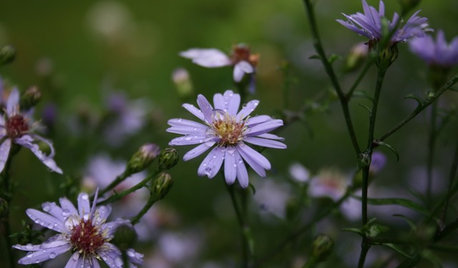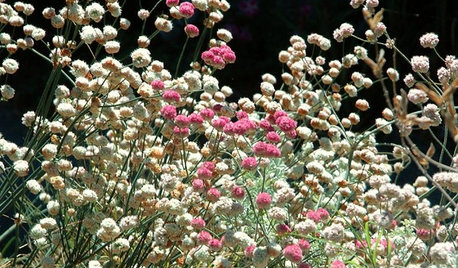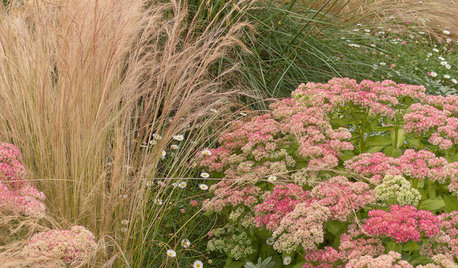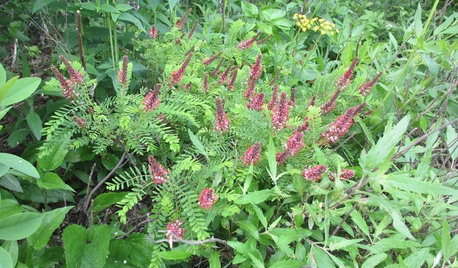We have had a dry summer. Five solid weeks of rain May-June and after that about 1/2" of rain in the following four months and counting. We have about 380 roses and we water with a hose. As a rule of thumb we water roses the first year after they're planted and then stop. This year wasn't as hot as last, when it got up to 100F every day in July, but on the other hand the wind blew great guns for months on end: it was like having the entire garden in a gigantic dryer. The supersaturation of the late spring rain carried us for a long time, and is probably the reason we didn't lose many roses, but now it's as dry as it can be. So how did the roses do?
Not many roses died, surprisingly. Most of the few Austins look extremely miserable, the chief exception being 'Sharifa Asma', a rose that rises continually in my esteem. If I had to make my garden at this point from scratch in the same place, it's the only Austin rose that would definitely find a place.
I'm not much of a fan of the Bourbons. However, they seem to be able to handle drought, heavy soil, full sun, wind--everything. I have one bed that's a real rose-killer, and the Bourbons there are clinging most tenaciously to life. They are 'Louise Odier', 'Variegata di Bologna', and 'Honorine de Brabant'. Also 'Zephirine Drouhin', which succumbed horribly to rust with the spring rains, then came back, not beautiful, but solidly alive. No fall bloom, of course, with no water. A new variety in a better spot is 'Souv. de St. Anne's', which is growing and flowering and promises to be a splendid rose.
I've also avoided the Hybrid Perpetuals, but a mystery rose used in making syrup that a friend gave me is very likely 'Géral Jacqueminot', and it got through the summer very well. Though tall and scraggly, it's one of the best looking roses in its bed, one that was exposed to the full, uncharitable brunt of the wind.
The Teas and Chinas came through pretty well. They may defoliate when it gets dry enough, but still manage to look cheerful and ready to leaf out again at the first rain. I have three plants of 'Mme. Berkeley': one, in the horrible bed, was truly suffering; the other two did fine and one has flowered this fall (none were watered). 'Spray Cécile Bruenner' ('Bloomfield Abundance') was splendid everywhere it was planted, and it went into some very sunny, dry, hot places. To my surprise I lost a plant of 'Archiduc Joseph', but 'Général Schablikine' above it lived in a brutal spot.
(Perhaps I ought to state that I'm not a sadistic gardener. We simply don't have ANY good ground; only some ground that is less bad than other ground.)
The Damasks overall did very well, including plants that we got in the previous fall and put in some of our better ground, then never watered this year. 'Quatre Saisons' in the western boundary bed is far and away the handsomest rose in the bed: the only one that actually looks thriving. It's worth having for its lush, richly green foliage alone, which is a good thing, as it shows no signs of flowering this fall. The Gallicas generally were less satisfactory. I had several in a bed of extremely heavy clay; some were killed by the rain, others by the drought that followed. Those in part shade and not-so-heavy ground did okay. The Damasks are living up to their reputation of tolerating heat and drought.
The Hybrid Musks didn't like the drought, and they especially didn't like the wind, but they all appear to have survived. The ones out of the wind and in half shade look fine. Those conditions also suit most of the once-blooming old roses.
One of the surprises was the Moss 'William Lobb', which grew handsomely in one of the ugliest places in the garden. 'Comtesse de Murinais', another Moss, also did well. The Alba 'Blanche de Belgique' laughs at heat and drought, but all my Albas looked good this year.
Melissa
















rjlinva
carolfm
Related Discussions
How tough are these roses?
Q
Tough Tough Tough tropicals. Ideas Please????
Q
How tough those Aloe hybrid are In summer?
Q
'Mme. Lambard' (and other roses) In Tough Times
Q